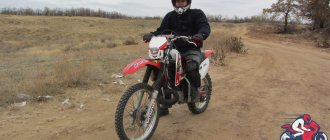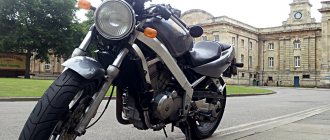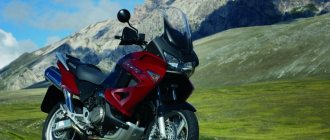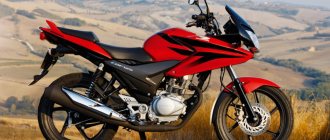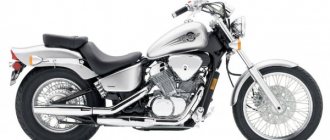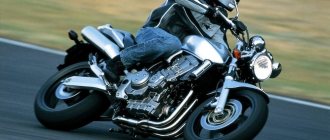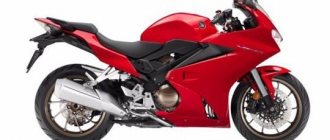- motorcycle model, Honda brand,
The Honda FTR 223 light road motorcycle model was first introduced in September 2000 and was produced until 2016. The motorcycle is a follower of the FTR (Flat Track Racer) series, namely the Honda FTR 250 model, produced between 1986 and 1989. However, unlike it, the new version of the Honda FTR 223 has received a more civilian design, making the motorcycle more suitable for use in the city and on dirt roads. The model was based on the enduro Honda XR200R.
Honda FTR 223 is equipped with a 1-cylinder, 4-stroke, air-cooled engine with a capacity of 223 cc. see, producing 19 hp. power and 21 Nm of torque. Maximum engine performance is achieved at 6000-7000 rpm. The use of a 2-valve cylinder head and certain engine settings made it possible to make the motorcycle high-torque at low and medium speeds, which increased the comfort of using the motorcycle in the city and on light off-road conditions.
The Honda FTR 223 model has a simple and reliable design: a classic steel frame, front disc brakes, rear drum brakes, a conventional telescopic fork at the front and a monoshock absorber at the rear, spoked wheels of 18′ radius of equal width.
Due to its reliability, light weight, efficiency and simplicity, the motorcycle is actively used for training beginners in motorcycle schools in many countries.
The common base of the FTR 223 is used on the retro classic Honda CB223S and enduro Honda SL230.
The main competitors of the Honda FTR 223 in the class:
Kawasaki Estrella 250
Suzuki TU250 (Volty, Grasstracker)
Yamaha TW225 / Yamaha TW200 / Yamaha Bronco 225
For whom
Here are the main features of the Honda FTR 223:
- ease of operation;
- compactness and lightness;
- ease of use.
This machine is a good choice for those who like motorcycles with a more or less classic exterior. Yes, the model looks modern, but the classic, even in a modern wrapper, retains its characteristic features.
Model history
2000 - start of production and sales. Model: Honda FTR223 (Japan). Factory designation: FTR223Y.
2001 - no significant changes. Model: Honda FTR223 (Japan). Factory designation: FTR2232.
2002 - appearance of the D-modification. Model: Honda FTR223 + FTR223D (Japan). Factory designation: FTR2232, FTR223A2, FTR223D2.
2003 - the regular version of the motorcycle loses the side plastic and receives minor visual changes. Model: Honda FTR223 + FTR223D (Japan). Factory designation: FTR2233.
2004 - no significant changes. Model: Honda FTR223 + FTR223D (Japan). Factory designation: FTR2234.
2005 - no significant changes. Model: Honda FTR223 + FTR223D (Japan). Factory designation: FTR2235.
2006 - no significant changes. Model: Honda FTR223 + FTR223D (Japan). Factory designation: FTR2236.
2007 - the model receives changes to meet new environmental requirements, slightly reducing the maximum power and increasing the curb weight. Visual changes to the models affected mainly colors. Model: Honda FTR223 + FTR223D (Japan). Factory designation: FTR2237.
2008-2016 - no significant changes. Model: Honda FTR223 + FTR223D (Japan). Factory designation: FTR2238.
Engine
The model has a four-stroke, one-cylinder engine. Its volume is 223 cm³. The motorcycle cannot be called powerful, because the maximum figure here is 19 hp. But is this not enough for city streets? After all, this lightweight bike, susceptible to gusts of wind, is still not very suitable for country roads. The peak torque here is 21 Nm. The speed at the limit is only 105 km/h.
Dimensions and weight
This model weighs 126 kg including fuel, and those who have been familiar with various motorcycles for a long time understand how little this is. The seat height is 780 mm and the wheelbase is 1395 mm. The FTR 223 measures 2080 mm in length, 910 mm in width, and 1115 mm in height. The tank volume is only 7.2 liters, which is quite enough.
Chassis and brakes
This classic road bike has a steel frame. His appearance is characteristic. The FTR 223 can be immediately recognized among a variety of models with a more modern appearance: spoked wheels, typical steering wheel contours, high round mirrors. And, of course, the dominant color is black.
The rear of the bike uses swingarm suspension along with a monoshock. At the front it is a telescopic fork. The rear brakes are drum, and the front brakes are single disc. Of course, the chassis cannot be called brilliant, but for such a small-sized motorcycle, it’s probably okay.
Review of the Honda FTR 223 motorcycle
that year in the fall I rode the FTR223 in Moscow for two days, the city and the forests, the emotions were positive, it easily goes over 100 km/h, but there is no balance shaft, wild vibrations, the girls will probably like it, and the prostate massage is good, these are all the minuses , the engine is unpretentious, high-torque like a tractor and simple as a slingshot. If you're interested, I can send you a personal contact with a friend who has owned it for quite a few years, and has never heard from him about FTR failures; both XRA and AX-1 had problems. Well, there is one more minus in the free sale of stars.
And it’s light, I just carried it across the railway road.
This is my first motorcycle after a 17-year break and therefore there is nothing to compare with. I took it in mid-August from Japan with a mileage of 21,300.98 for 110,000 rubles. And having driven 700 km, I handed it over for winter storage to the same place where I bought it. What I managed to understand: the tank is too small (7.5 l), 223 cubes is also not a lot, the cruising speed is 90-100, then it screams, but it gets the stated 120, it’s quite nimble in traffic jams and along the curbs with pleasure...Forest paths are his element! For a dacha! - said the seller during the sale and was 100% right. Appearance? Where did you buy a trophy motorcycle? - the guys at work asked and I smiled - it looks like they did it for me. to order and installed a luggage system - it just turned out great and sliders too, just in case. True, the trunk is to the detriment of the second number - there is no place for it, well ... I wasn’t going to carry anyone with it anyway. All that was left was to buy bags in the studio during the winter attach all sorts of fasteners to the moto and buy a new Akum, otherwise the season closed earlier than I wanted - the old one died the morning after the frost. That's the whole review, I guess. I'm happy with the moto, but I'm looking towards the XP650L, but that's another story. Hello everyone .
Greetings!
I've had the same motorcycle for two years now. I use it as a training one.
The motorcycle showed its best side. We bought it for short fat people, but it turned out that everyone likes it. The engine is very torquey. True, when overheated, the valves begin to rattle loudly, but I suspect that my particular specimen was caught like that.
I suspect there will be few problems with the bike simply due to the small number of mechanical parts. because it is as simple as a Kalashnikov assault rifle.
Personally, I have encountered the following so far:
1. The rear sprocket is exclusively original and nothing from the catalog fits. Must be ordered from Japan. The unfortunate owner of a similar device got out of it last year by installing a crown on a turned workpiece. I don’t know yet what I’ll do myself, I’m going to order it from the factory. The front sprocket is available from alternative manufacturers.
2. The air filter is also original.
3. The clutch and front brake levers could not be found. The broken brake lever was welded for me in a workshop, but I plan to simply replace the brake lever with something more common, so as not to have to search all over the city later. If you don’t have such an opportunity, then at least file them under the ring finger, so that if you fall, it breaks off there, and not at the very base.
4. Rear brake pads are also not in the catalogs. But it’s easier here; you can just rivet the friction linings together, and even then not soon.
5. Rear tires of rare size: 120x90-18. This size is very rare, you need to look for it specifically and in advance. So it makes sense to take care of it now; it’s better to let it lie on the closet for the time being. Everyone here criticizes the K180, apparently with good reason. But on our dusty asphalt it holds up very well, “scratching” to the hard surface where the road tires begin to slide on the “dust wedge.”
I'm happy with the motorcycle. As soon as I find a channel for the supply of original spare parts, I will buy a second one of the same type or an SL230.
Purchased in February 2014, with a mileage of 8000 km. I almost didn’t run around the Russian Federation, I stood in the seller’s garage. Spent the summer in the village. The emotions are positive.)) A very light and comfortable motorcycle, with a height of 188 cm I didn’t feel any discomfort at all. This is my first Japanese motorcycle, before that there were IZHs)))) Which were inherited from our fathers and grandfathers)) I gained some repair experience, but I’m very glad that it was not useful this year with this motorcycle)
Very high-torque engine. Clear gearbox, without any problems like some)) In principle, Honda is not wrong in this, as far as I know)
I bought the motorcycle for a motorcycle school, because sometimes people come with a lot of weight and the standard YBR125 carries them very poorly. In terms of low-end traction, the engine showed its best side. It pulls great and accelerates quickly. In general, the motorcycle concept is great for short people weighing 100 kg or so.
The motorcycle itself is very light. Subjectively, even lighter than YBR125.
Very resistant to overheating. Withstood the extremely hot summer of 2010 with dignity. Overheating, the valves begin to make noise and crackle. At first I was tense, took it to the service center, where they checked everything and said that such noise is normal for air vents.
Small gas tank volume. On the highway you need to refuel once every 200-220 km, on the site once every day and a half. If you take a motorcycle for life, then this is not enough. Here the YBR125, with its range of 400 km on the highway and 350 in the city, leads with terrible force.
Very soft suspension. Standard shock absorber without adjustments.
It's hard to find spare parts. #38mm forks, front brake pads from SL230, original rear ones. The engine is quite common, but not with us. My fate is made easier by tolerance for the use of non-standard components, since the device is utilitarian. There are a lot of offers at Japanese auctions, but I need to figure out who to work with, I don’t know yet.
My opinion: a motorcycle is best suited for a summer cottage: driving to the river or to the village for groceries. Excellent Dunlop K180 tires, interchangeable as they wear out, handle perfectly on dirt, wet roads, and sand. In general, these tires are intended for racing on a cinder track, but, apparently, something happened to these races and the tires became much wider and smaller in diameter. Excellent walking along standard Russian mud roads in spring and autumn (in memory of “Tula”)
In the city you will constantly refuel. Especially in hot weather it starts to consume fuel.
On the highway, calmly fit into a column of tractors - the speed limit is appropriate.
You can’t find consumables anywhere (spare parts, even more so). Only to order and always in advance.
For my purposes, the motorcycle fits perfectly. I can’t imagine who else might need it in Russia. If only to go crazy and drive on the beach or go out with friends to shit.
Next time I will take the Yamaha TW225 - the same concept, only I was trading in Panavto and there are more spare parts. The potential high cost of the rear tire is more than compensated by the availability of consumables (which is much more important in everyday use)
